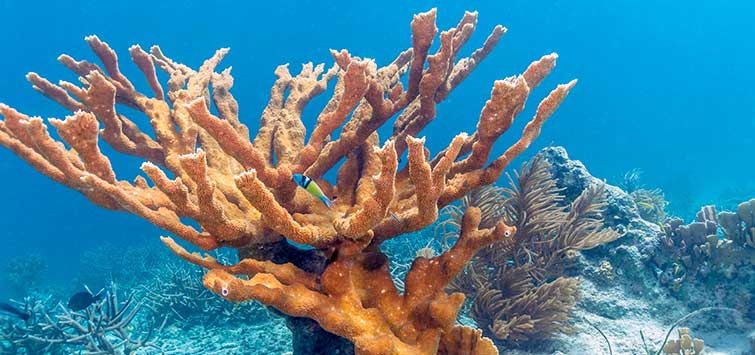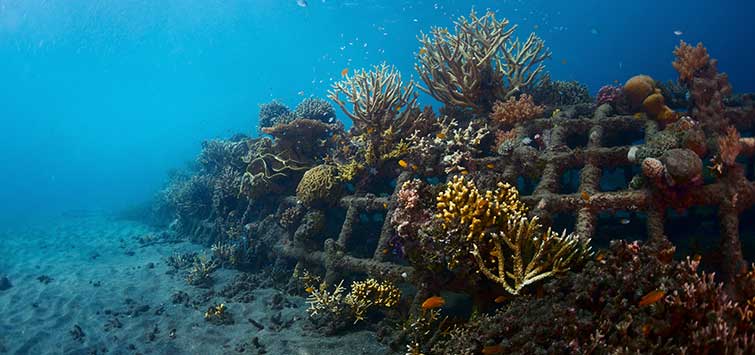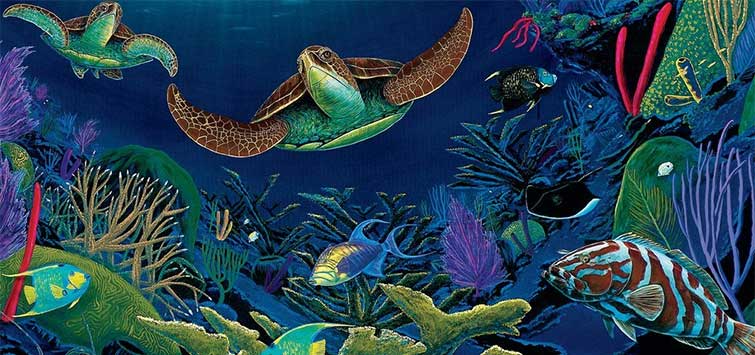SECORE
Author: Shari Horowitz
Coral fragging has become a popular and eco-friendly part of reefkeeping, but it does nothing to maintain the genetic diversity of captive coral stocks. TFH’s associate editor speaks with SECORE, an organization developing cutting-edge techniques to encourage sexual reproduction of corals for the aquarium hobby, and ultimately to repopulate damaged reefs.
Saving the Reef
The world’s coral reefs are currently facing the possibility of total extinction. Threats such as global warming and ocean acidification, overfishing, and pollution have led to mass coral bleaching and die-off events. With almost every reef having experienced some level of damage, the question arises: What can be done?
For reef hobbyists, who have both an intimate knowledge of and an extreme appreciation for corals, helping to save the reef is a priority. While the aquarium hobby accounts for a nearly insignificant amount of reef destruction worldwide in comparison to such pressures as climate change, commercial development, dynamite and cyanide fishing for the food market, agricultural runoff, ship grounding, anchor damage, and storm damage, to name but a few, it may be aquarium hobbyists who are in the best position to minimize the impact of their activities on the reefs, and perhaps even help save many coral species from extinction.
One way to minimize the impact from the aquarium hobby on reefs now commonly utilized is fragging—dividing parent coral colonies into pieces that then grow into new parent colonies. However, the problem with fragging, because it is a form of cloning, is that it does not contribute to the overall genetic diversity of corals. That is where SECORE comes in.
Background
Sexual Coral Reproduction, or SECORE, is an organization that involves public zoos and aquariums, as well as marine scientists, to address coral conservation issues—particularly the sexual reproduction of reef-building corals around the world.
Concept
The idea for SECORE was developed by Dr. Dirk Petersen back in 2001, with the help of his colleague Michael Laterveer, when he started to work with the Rotterdam Zoo in the Netherlands. They were hoping to combine the knowledge of professional aquarists and coral scientists in order to make progress in the field of coral husbandry.
Petersen says, “Already during my master’s thesis, I settled coral larvae in aquaria back at the University of Munich in 1998 and knew that this will be an important feature for future of coral husbandry (years later we realized that it also may serve reef restoration). At that time, I was amazed just looking at the larvae settling on primitive substrates, which I basically made at home from clay using my mom’s kitchen tools for making Christmas cookies.”
SECORE Past and Present
In 2002 SECORE was officially launched, although it only involved a limited number of European public aquariums. An overwhelmingly positive response led the chair of the Association of Zoos and Aquariums’ Coral Reef Conservation Action Partnership, Mike Brittsan, to invite SECORE to the annual meeting of all United States public aquaria. Today there are over 50 member institutions throughout Europe, the United States, and Japan. Some well-known figures in the aquarium hobby, such as Eric Borneman, Mitch Carl, and Charles Delbeek, are also involved.
Coral Biology Review
The asexual reproduction of corals—budding of the individual coral polyps—is familiar to most aquarists in the form of fragging, mentioned earlier. What many aquarists may not know is that corals also exhibit sexual reproduction through various strategies. First off, most corals are hermaphroditic (produce both male and female gametes), but about a third of coral species have separate sexes (are gonochoric).
There are two primary means by which corals reproduce sexually. Broadcast spawners typically release their eggs and sperm en masse into the water column once a year, a few nights after a full moon. Fertilization occurs while drifting at the water’s surface. A few days later, the fertilized embryos develop into coral larvae known as planulae.
Brooders internally fertilize their embryos and release larvae. They reproduce more often than broadcast spawners and send out larger larvae, but in smaller numbers.
Practical Applications
Since its inception, 25 species of corals—booth brooders and broadcast spawners—have been raised in SECORE aquaria from larvae. Several species of both Atlantic and Pacific brooders have already sexually reproduced in the aquarium setting. However, inducing a mass spawning event in an aquarium setting is much more difficult.
“Up to now, [SECORE participants] collect gametes of broadcast spawners in the field during mass spawning events, and then raise hundreds of thousands of larvae from ex situ fertilized gametes,” Petersen says.
Different Settlement Tiles
The method of raising corals has changed as scientists have worked with coral larvae. Instead of using static bins and constantly transferring larvae to bins with clean water, larvae are cultured using SECORE’s kreisel systems, basically tanks that keep the larvae circulating in the water column so that they are not damaged (a similar technique is used to keep jellyfish—close relatives to coral—suspended in the water column). SECORE now uses larger settlement setups and a different style of settlement tile from when they started.
Using this collection and raising technique, SECORE works to save critically endangered corals, with one successful example being the elkhorn coral Acropora palmata. Although it is known to be an extremely delicate coral, more than 3500 juveniles were established in public aquaria throughout the U.S. and Europe.
Reproduction on the Rise
Petersen explains, “This shows the potential of using sexual reproduction for stocking aquaria; it will be a task in the future to produce corals of many more species in large quantities for stocking public aquaria and, by the way, also those of the hobby, and last but not least, there is a great chance for large-scale reef restoration. In principle, you can produce several thousand juveniles from only using two donor colonies.” He also cautioned that, even though sexual coral reproduction is a powerful tool, it comes with a great deal of responsibility, since you are influencing the genetic diversity in both captive and natural populations.
Besides spawning and raising corals, SECORE is also working to create a coral genetic bank for the future.
Petersen says, “So far, we only have stored frozen sperm of the critically endangered elkhorn coral in three genetic banks in the U.S. and the Netherlands. Dr. Mary Hagedorn, who is member of the SECORE Science Advisory Board, is currently the only person in the world who is able to cryopreserve coral sperm. We hope to get far more species cryopreserved in the near future; however, this will highly depend on whether Mary will get the funding to be able to continue her work in the future.”
Cryopreserving Eggs?
Due to their relatively large size, it is difficult to cryopreserve eggs. Additionally, coral larvae are sensitive to chilling and will therefore also be either difficult or impossible to cryopreserve in the future. However, SECORE is looking into the possibility of cryopreserving small polyp aggregates or stem cells for the genetic bank.
Future Endeavors
Mass Spawning
One of their current goals is to induce a mass spawning event in the aquarium and to raise up the embryos from there. Petersen predicts, “I believe that it is just a question of time until it will be possible to induce mass spawning in a closed-system aquarium…There are some observations on individual corals that have spawned in aquaria of hobbyists and in large public exhibits.”
Finding the Light
Petersen says that one of the keys to spawning in a closed system is exposure to natural sunlight and moonlight, with temperatures that reflect natural variations. The Reef HQ Aquarium in Townsville, Australia has such a setup and has seen the regular spawning of corals. The same is true for the Waikiki Aquarium in Hawai‘i.
Petersen emphasizes, “Besides providing natural triggers such as moonlight and temperature, I believe we also have to look at the coral itself—does it have enough of an energy surplus to develop gametes or does it lose energy constantly due to high competition in an overstocked exhibit? Corals need lots of energy to reproduce, probably just providing light for their algae symbionts might not be enough—corals are animals and need food!”
He indicated that too much fragging may lead to infertility, since coral maturity is based on colony size, and that size is different for every species. Small, crowded aquariums further contribute to this problem because corals may be unable to reach their mature size. Additionally, crowding corals increases competition for food, thereby reducing the coral’s energy reserves.
Reef Restoration
The last and arguably most important goal for SECORE is to use captive-bred corals for reef restoration purposes. The elkhorn corals, for example, are typically taken back to participating institutions where they are raised and used in displays. However, last year SECORE conducted a trial that took larvae settled on specific tiles and put them back onto the reef in Puerto Rico. A few months later some juveniles were found, which Petersen called a promising result.
He adds, “We are about to start a larger project in CuraÇao and maybe in Puerto Rico from 2010. This year, we will do a pre-study at both locations during the elkhorn coral spawning in August, and at the end of this year we plan to build a coral nursery at the field research station in CuraÇao (CARMABI). Funding is provided by different organizations such as the National Oceanic and Atmospheric Administration (NOAA), the Green Foundation, the Connie and Clyde Woodburn Foundation, or the European Union of Aquarium Curators (EUAC).”
This is especially important given recent research from the Royal Society of London that suggests the potential extinction of all coral reefs and marine organisms that produce a calcium-carbonate-based skeleton in the next 50 to 100 years due to the increasing acidity of the oceans.
Relating Back to Aquarists
All of this may sound rather far off and academic, but it relates directly back to anyone keeping a reef aquarium. Petersen is certain “there will be a time coming to get hobbyists more involved in captive coral breeding to make captive-bred corals available to the hobby.”
Fifteen years ago Petersen started as a hobbyist working with both soft and stony corals in a 100-gallon tank. “Actually, the hobby gave me all the basic tools which I still apply today when setting up and managing large coral exhibits of several 10,000 liters [thousands of gallons]. And I am not the only one—many of my colleagues in SECORE started as hobbyists. We all highly acknowledge the dedication and knowledge of the hobbyists!” he says.
Petersen also used to spend a lot of time with an aquarium club in his hometown in Germany. He still occasionally gives lectures for hobbyists, although he has less time to do so now than he used to.
He noted that, over the years, many of his coral husbandry practices have remained the same. One major difference, however, is the importance he places on feeding corals—he used to pay little attention to it but now says that feeding your corals, especially small-polyped stony corals, is extremely important.
References and Resources
SECORE: www.secore.org
ZSL Institute of Zoology: www.zsl.org/science/news/join-our-campaign-to-save-the-worlds-coral,1209,AR.html
See the full article on TFH Digital http://www.tfhdigital.com/tfh/200910/#pg115

.png?h=595&iar=0&w=2781&hash=5FD5E69473BCC22199FBFA2FB71B6033)



